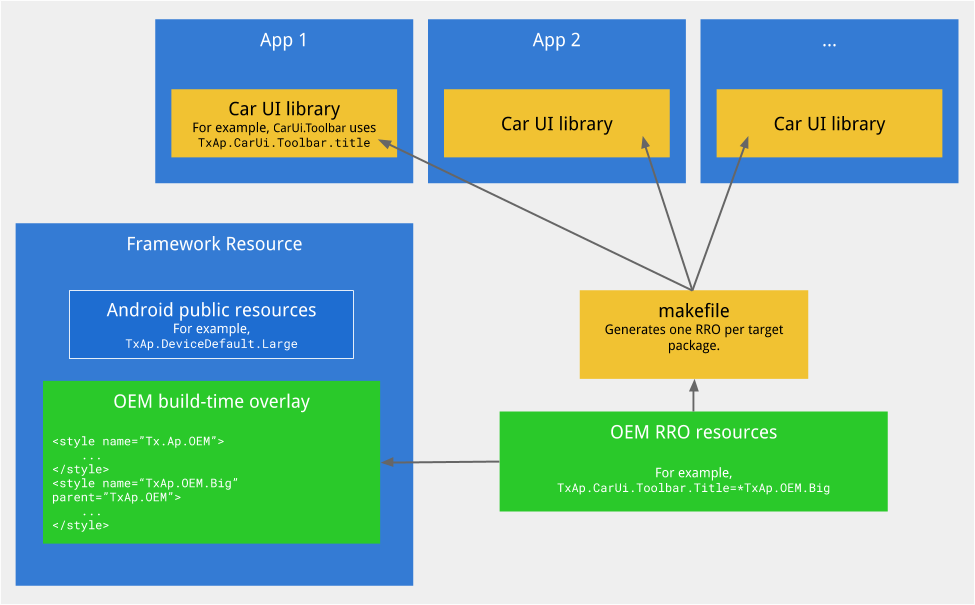कार के यूज़र इंटरफ़ेस (यूआई) टूलकिट में, यूआई डेवलपमेंट फ़्रेमवर्क दिया गया है. इसका इस्तेमाल करके, यह पक्का किया जा सकता है कि कार में मौजूद ऐप्लिकेशन (Google के ऐप्लिकेशन और सिस्टम और वेंडर के ऐप्लिकेशन) ये काम कर सकें:
-
इंफ़ोटेनमेंट यूज़र इंटरफ़ेस (यूआई)/यूज़र अनुभव (यूएक्स) में एक जैसी सुविधाएं. एक जैसा अनुभव, उपयोगकर्ता के लिए एक ऐसी सुविधा है जिससे वह किसी इन्फ़ॉर्टेनमेंट सिस्टम के साथ इंटरैक्ट करने के तरीके का अनुमान लगा सकता है. यह अनुमान, उसी सिस्टम के साथ इंटरैक्ट करने के पिछले अनुभवों के आधार पर लगाया जाता है.
-
पसंद के मुताबिक बनाना. OEM, वाहन के इंटीरियर और हार्डवेयर के साथ फ़ंक्शन को बेहतर तरीके से इंटिग्रेट करने के लिए, सिस्टम के लुक-एंड-फ़ील में बदलाव कर सकते हैं.
कार की यूज़र इंटरफ़ेस (यूआई) लाइब्रेरी के इंटिग्रेशन के बारे में ज़्यादा जानने के लिए, ये पेज देखें:
- ऐप्लिकेशन में कार की यूज़र इंटरफ़ेस (यूआई) लाइब्रेरी को इंटिग्रेट करना
- ऐप्लिकेशन को पसंद के मुताबिक बनाना
- पसंद के मुताबिक फ़ॉन्ट जोड़ना
- कार के यूज़र इंटरफ़ेस (यूआई) की प्राथमिकताओं को पसंद के मुताबिक बनाना
- CarUiListItem
- CarUiRecyclerView को पसंद के मुताबिक बनाना
- रनटाइम रिसॉर्स ओवरले से जुड़ी समस्याएं हल करना
- प्रॉडक्ट की जानकारी
- अनुबंध A, आरआरओ के साथ काम करना
- अपेंडिक्स B, कस्टमाइज़ेशन के दिशा-निर्देश
कार की यूज़र इंटरफ़ेस (यूआई) लाइब्रेरी के बारे में जानकारी
कार की यूज़र इंटरफ़ेस (यूआई) लाइब्रेरी, स्टैटिक तौर पर लिंक की गई लाइब्रेरी है. इसमें कॉम्पोनेंट और संसाधनों का एक सेट होता है. इनका इस्तेमाल करके, ये काम किए जा सकते हैं:
- सिस्टम और OEM ऐप्लिकेशन (Gerrit)
- Android Automotive (AAOS) ऐप्लिकेशन
यह लाइब्रेरी इन कामों के लिए इस्तेमाल की जाती है:
-
कस्टमाइज़ेशन एपीआई, इनके हिसाब से:
- यह तय करना कि किन संसाधनों को पसंद के मुताबिक बनाया जा सकता है. इनमें रंग, डाइमेंशन, और ड्रॉआउट शामिल हैं.
- संसाधनों को एपीआई के तौर पर इस्तेमाल करना, ताकि वे पुराने सिस्टम के साथ काम कर सकें.
- Android 9 और Android 10 में उपलब्ध कराए गए कुछ समय के लिए काम करने वाले समाधान और लंबे समय तक काम करने वाले समाधान के बीच काम करने वाली लेयर. फ़िलहाल, लंबे समय तक काम करने वाला समाधान तैयार किया जा रहा है.
रिसॉर्स ओवरले
Android फ़िलहाल, अपनी पसंद के मुताबिक बदलाव करने के कई तरीके उपलब्ध कराता है. इसके लिए, आपको उन सबसिस्टम और ऐप्लिकेशन में कोई बदलाव करने की ज़रूरत नहीं होती जिन पर असर पड़ा है:
-
बिल्ड टाइम ओवरले. पसंद के मुताबिक बनाने की यह सुविधा, Android सिस्टम इमेज को बनाने के समय लागू की जाती है. बिल्ड के दौरान, सिस्टम में मौजूद सभी ऐप्लिकेशन को उनके
resफ़ोल्डर और टारगेट मेकफ़ाइल में तय किए गएoverlayफ़ोल्डर से रिसॉर्स मिलते हैं. -
डाइनैमिक रनटाइम ओवरले (डाइनैमिक आरआरओ). इन खास APK में, सिर्फ़ संसाधन और एक मेनिफ़ेस्ट फ़ाइल होती है. इससे यह पता चलता है कि इनका असर किस टारगेट APK पर पड़ेगा. डाइनैमिक आरआरओ को सिस्टम इमेज से अलग से कॉम्पाइल और डिप्लॉय किया जाता है. साथ ही, इन्हें चालू और बंद किया जा सकता है. जब सिस्टम किसी खास ऐप्लिकेशन के लिए रिसॉर्स लुकअप करता है, तो वह उस ऐप्लिकेशन को टारगेट करने वाले किसी भी आरआरओ की जांच भी करता है. साथ ही, यह भी देखता है कि आरआरओ में उसी नाम का कोई रिसॉर्स है या नहीं.
-
स्टैटिक रनटाइम ओवरले (स्टैटिक आरआरओ). डाइनैमिक आरआरओ की तरह ही, ये हमेशा चालू रहते हैं. इसका मतलब है कि सिस्टम इमेज को पूरी तरह से अपग्रेड किए बिना, इन्हें अनइंस्टॉल या अपडेट नहीं किया जा सकता. स्टैटिक आरआरओ, बिल्ड टाइम और डाइनैमिक रनटाइम ओवरले के बीच इंटरमीडियरी के तौर पर काम करते हैं.
यूज़र इंटरफ़ेस (यूआई) कॉम्पोनेंट के अलावा, कार यूज़र इंटरफ़ेस लाइब्रेरी, स्टैटिक आरआरओ के सेट का इस्तेमाल करके, सीधे तौर पर संसाधनों (हर ऐप्लिकेशन में स्टैटिक तौर पर लिंक किए गए) को OEM संसाधनों के साथ ओवरले करने का तरीका उपलब्ध कराती है. OEM को एक फ़ोल्डर उपलब्ध कराना होगा, जिसमें उनके रिसॉर्स ओवरले और टारगेट किए गए ऐप्लिकेशन की सूची शामिल हो. बिल्ड के दौरान, कार यूज़र इंटरफ़ेस (यूआई) लाइब्रेरी का इन्फ़्रास्ट्रक्चर, इस जानकारी का इस्तेमाल करके, टारगेट किए गए हर ऐप्लिकेशन के लिए एक स्टैटिक आरआरओ जनरेट करेगा.

पहली इमेज. कार की यूज़र इंटरफ़ेस (यूआई) लाइब्रेरी के कॉम्पोनेंट
ऊपर दी गई इमेज में:
-
हरा. OEM की ओर से उपलब्ध कराए गए कस्टमाइज़ेशन, जो बिल्ड टाइम और रन टाइम के ओवरले संसाधनों का एक मिक्स है.
-
पीला. कार यूज़र इंटरफ़ेस (यूआई) लाइब्रेरी से मिलने वाली सहायता. इसमें ओवरले किए जा सकने वाले संसाधन, कॉम्पोनेंट (Java कोड), और ज़रूरी आरआरओ जनरेट करने के लिए सहायता शामिल है.
-
नीला. पसंद के मुताबिक बनाए जा सकने वाले टारगेट. इनमें फ़्रेमवर्क, सिस्टम ऐप्लिकेशन, वेंडर ऐप्लिकेशन, और GAS ऐप्लिकेशन शामिल हैं. ये ऐप्लिकेशन, यूज़र इंटरफ़ेस (यूआई) एलिमेंट को पसंद के मुताबिक बनाने के लिए, कार की यूज़र इंटरफ़ेस (यूआई) लाइब्रेरी का इस्तेमाल करते हैं.

